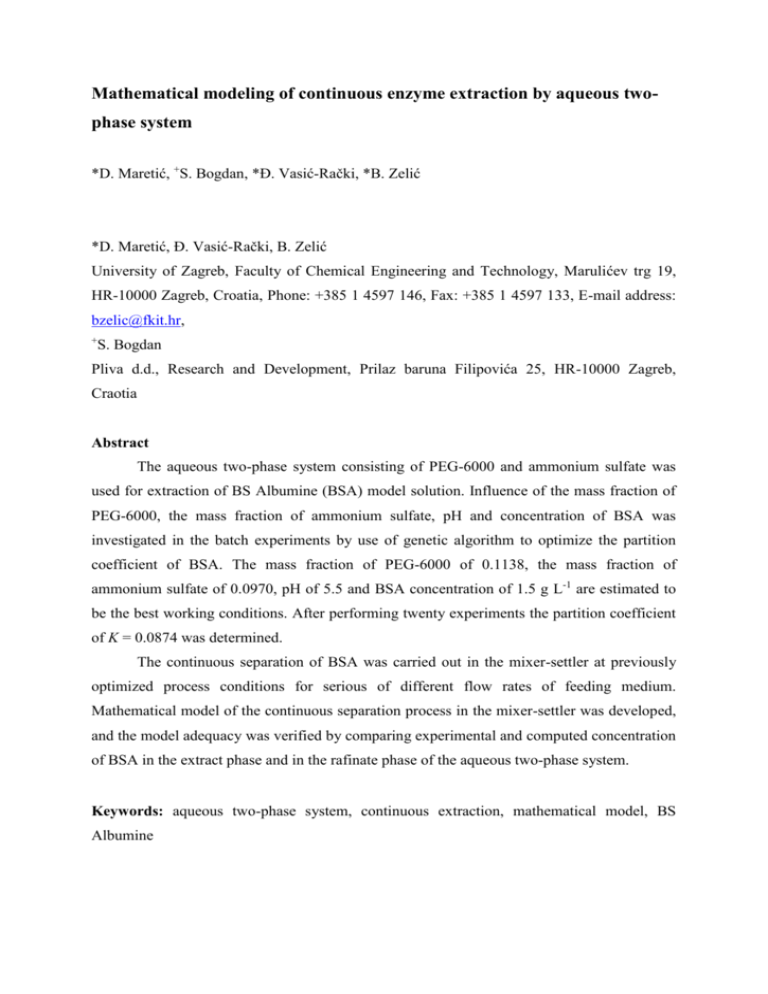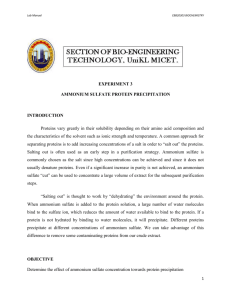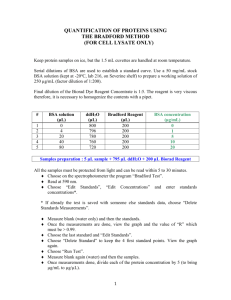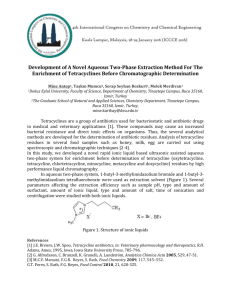Mathematical modeling of continuous enzyme extraction by
advertisement

Mathematical modeling of continuous enzyme extraction by aqueous twophase system *D. Maretić, +S. Bogdan, *Đ. Vasić-Rački, *B. Zelić *D. Maretić, Đ. Vasić-Rački, B. Zelić University of Zagreb, Faculty of Chemical Engineering and Technology, Marulićev trg 19, HR-10000 Zagreb, Croatia, Phone: +385 1 4597 146, Fax: +385 1 4597 133, E-mail address: bzelic@fkit.hr, + S. Bogdan Pliva d.d., Research and Development, Prilaz baruna Filipovića 25, HR-10000 Zagreb, Craotia Abstract The aqueous two-phase system consisting of PEG-6000 and ammonium sulfate was used for extraction of BS Albumine (BSA) model solution. Influence of the mass fraction of PEG-6000, the mass fraction of ammonium sulfate, pH and concentration of BSA was investigated in the batch experiments by use of genetic algorithm to optimize the partition coefficient of BSA. The mass fraction of PEG-6000 of 0.1138, the mass fraction of ammonium sulfate of 0.0970, pH of 5.5 and BSA concentration of 1.5 g L-1 are estimated to be the best working conditions. After performing twenty experiments the partition coefficient of K = 0.0874 was determined. The continuous separation of BSA was carried out in the mixer-settler at previously optimized process conditions for serious of different flow rates of feeding medium. Mathematical model of the continuous separation process in the mixer-settler was developed, and the model adequacy was verified by comparing experimental and computed concentration of BSA in the extract phase and in the rafinate phase of the aqueous two-phase system. Keywords: aqueous two-phase system, continuous extraction, mathematical model, BS Albumine 1 Introduction Aqueous two-phase systems (ATPS) are formed by mixing two or more polymers or a structuring salt and a polymer with water. Usually polyethylene glycol (PEG) and ammonium sulfate (AMS) (or system PEG-dextran) are required. ATPS are commonly used for the separation of enzymes from cells or cell debris and also for the separation of enzyme from each other 1. Despite the fact that ATPS have a great potential for the extraction of different bioproducts 2 - 14, it is especially suited for the large scale isolation of proteins when large volumes have to be processes. The aqueous environment constitutes mild conditions for biological material due to the high water contents and the low surface tension between the phases, so that denaturation which often occurs in organic solvents hardly takes place 15. Furthermore, proteins can be isolated on large-scale using commercially available equipment, with relatively low-cost chemicals, and time consumption is lower compared to the conventional separation methods such as batch centrifugation and ion exchange chromatography 16. The general properties of ATPS have been studied by several researchers 17, 18. However, the mechanism governing the partition of biological materials is still not well understood. The observed partition coefficient is a result of van der Waals, hydrophobic, hydrogen bond, and ionic interactions of the bio-molecules with the surrounding phase. ATPS separate biopolymers according to their size, charge, and surface characteristics. Therefore, the partition coefficient can be influenced by the number of phase system parameters such as the concentrations and molecular weights of the phase-forming compounds, type and concentration of salting-in ions, temperature and pH of the system, etc 19. The effect of these parameters must be studied in order to develop empirically suitable extraction conditions. In this work the aqueous two phase system, consisting of PEG-6000 and ammonium sulfate, was used to investigate the behavior of batch and continuous system for extraction of BS Albumin model solution. The batch experiments were used to examine the effects of pH, concentration of PEG-6000, concentration of ammonium sulfate and the concentration of protein model solution on partitioning in aqueous two phase system. The partition coefficient was optimized using the genetic algorithm. Genetic algorithm (GA) is a stochastic optimization method based on the principals of evolution. It is quite commonly used for experimental optimization, but is also used for 1 parameter estimation of the nonlinear systems 20. It can also be used for optimization of initial conditions when mathematical model of the process is available. In comparison to other methods, GA considerably decreases the number of experiments 21. GA was proved to be a reliable method for the optimization of process conditions for protein extraction in the PEGsalt system 2, 22. Since GA is not based on any assumption it can easily cope with irregularities of the aqueous two-phase system. It is neither harmed by very small values nor is it limited at the maximum. In comparison to other optimization methods (e.g. steepest ascent, simplex), GA does not need to be further adopted or limited just for beginning of the optimization process. The continuous separation of BSA model solution in aqueous two-phase system was carried out in the mixer-settler at process conditions previously optimized in batch experiments. Serious of different flow rates of feeding and outgoing streams were applied in order to investigate process behavior in the continuous system. Considering the kinetic of phase separation and the design of the mixer-settler the mathematical model of continuous separation process was developed and applied to describe the continuous separation of BSA model solution in the mixer-settler. The model was verified comparing the computed and experimental data. Success of the extraction process of BSA was characterized through the efficiency of used mixer-settler. 2 Mathematical Model of the Continuous Aqueous Two-phase Extraction In order to describe continuous extraction process, a mathematical model based on the flow of process streams, mass transfer, phase chemical concentrations and protein concentrations was formulated. It describes the time dependency of concentration of PEG6000 (PEG), ammonium sulfate (AMS) and BSA model solution in the mixer (mix) (Equations 1-4) and in the settler section (Equations 5-12) respectively. Furthermore, model is extended for each phase in the settler section, namely for the rafinate (R) phase (Equations 6, 8, 10 and 12) and the extract (E) phase (Equations 5, 7, 9 and 11). The following constraints were formulated and used: - mixture is ideally mixed in the mixer section; - each phase, namely, the rafinate and the extract phase of the settler section are individually and ideally mixed. The following system of balance equations may be derived for the process: 2 a) Settler section: d mmix q0 q1 dt mix d mmix wPEG dt mix d mmix wAMS dt mix d mmix wBSA dt (1) mix wPEG,0 q0 wPEG q1 (2) mix wAMS,0 q0 wAMS q1 (3) mix wBSA,0 q0 wBSA q1 (4) b) Mixer section * d mE q2 k1 mE mE t dt (5) * d mR q1 q3 k1 mE mE t dt (6) E d mE wPEG dt R d mR wPEG dt E d mE wAMS dt R d mR wAMS dt E d mE wBSA dt R d mR wBSA dt E E E wPEG q2 k1 mE wPEG mE t wPEG t (7) mix R E E wPEG q1 wPEG q3 k1 m E wPEG mE t wPEG t (8) E R R wAMS q2 k2 mR wAMS mR t wAMS t (9) mix R R R wAMS q1 wAMS q3 k2 mR wAMS mR t wAMS t (10) E R R wBSA q2 k3 mR wBSA mR t wBSA t (11) mix R R R wBSA q1 wBSA q3 k3 mR wBSA mR t wBSA t (12) * * * * * * * * * * * * where m is mass, w is mass fraction, q0 is mass flow rate of the stream feeding the mixer section, q1 is mass flow rate of the stream feeding the settler section, q2 is mass flow rate of the stream draining the extract phase, q3 is mass flow rate of the stream draining the rafinate phase, k1, k2 and k3 are the phase equilibrium constant rates for PEG, AMS, and BSA respectively, and t is time. m* and w* indicate equilibrium mass and equilibrium mass fraction, respectively. 3 3 Materials and Methods 3.1 Materials PEG-6000 with an average molecular weight of 6000, ammonium sulfate, and Bovine Serum Albumine (BSA) were obtained from ''Merck''. Two-phase systems were prepared from the stock solutions of PEG-6000, ammonium sulfate, BSA, mono- and dibasicpotassium phosphate and deionized water. Concentration of stock solutions of PEG-6000 and ammonium sulfate were 40 % (w/w). The concentration of NaCl of 0.9 % (w/w) was used to prepare stock solution of BSA with an accurately known concentration of 10 g/dm3. Different stock solutions of K2HPO4 and KH2PO4 were used to prepare the aqueous two-phase system at different pHs 23. 3.2 Aqueous Two-phase Extraction - Batch System Aqueous two phase partitioning experiments were performed at 20 °C by mixing the determined volume of the phase forming polymer solution with solutions of salt and BSA in the graduate cylinder. The buffer solution was then added to obtain the final volume of 5 cm3. The system was mixed by vortexing and then left overnight for separation of phases. After 24 hours samples were carefully withdrawn from the top (extract) phase and from the bottom (rafinate) phase and analyzed for BSA concentration. Each experiment was done in triplicate. Partition coefficient, K, was calculated as a ratio between equilibrium concentrations of BSA in the extract and in the rafinate phase. 3.3 Aqueous Two-phase Extraction - Continuous System The continuous separation of BSA was performed in the mixer-settler shown in Figure 1 at process conditions previously optimized in the batch system. Mixer-settler consisted of two sections, cylinder form mixer section with capacity of 103 cm3 (1), and cone shaped edges settler section with capacity of 261 cm3 (2). A settler section was divided in two compartments: bottom phase compartment (2a) (rafinate) and top phase compartment (2b) (extract). The mixer and the settler sections were placed inside the thermostated cylinder vessel (3). Stock solutions of PEG-6000, ammonium sulfate, BSA and buffer pH 5.5 were fed into the mixer section of the mixer-settler and mixed. When the mixture approached the edge of the mixer section, it overflowed into the settler section where the phases separate. When mixture approached flooding limit two pumps for draining the rafinate and the extract phase where turned on and set at a desired constant value. During the separation process the samples 4 from the rafinate and the extract phase were taken in predetermined time schedule and analyzed for concentration of BSA and in the steady-state for concentrations of PEG-6000 and ammonium sulfate. Additionally, flow rate of each process stream was controlled. The continuous separation was carried out at 20 C for serious of different flow rates of feeding and outlet streams ranging from 10 cm3/min to 50 cm3/min. q3 q0 Rafinate q2 2b Extract 2 2a 1 3 Buffer BSA pH = 5.5 c = 1.5 g dm-3 Figure 1 PEG-6000 40% w/w (NH4)2SO4 40 % w/w Schematic diagram of the experimental set-up used for continuous aqueous two-phase extraction of BSA model solution. 1 – mixer section; 2 – settler section; 2a – rafinate compartment; 2b – extract compartment; 3 – thermostated cylinder vessel; q0 - stream feeding the mixer section; q2 - stream draining the extract phase; q3 – stream draining the rafinate phase 3.4 Analysis In addition to the BSA concentration determination, the absorbance of each sample was measured using the spectrophotometer (Lamda EZ 210, Perkin Elmer) at 280 nm. The contents of phase forming components (PEG and AMS) were quantified simultaneously using a HPLC system with a Maxi Star K-1001 pump, a K1501 LPG Solvent organizer (Knauer, Germany), a HPLC Control Box (Knauer, Germany), a Midas autosampler (Spark, Netherlands) and ELSD 2000 detector (Alltech, USA). Data were acquired and processed by Eurochrom software (Knauer). The chromatographic separation was carried out 5 at 40 C on a Symmetry Shield RP18 column (5 m particle size, 250 x 4.6 mm I.D.) protected by a guard column (20 x 4.6 mm I.D. Symmetry C18, Waters, USA). Sample injection volume was 50 l and mobile phase flow-rate was set to 1 ml/min. Mobile phase A was constituted by Methanol (Merck, Germany) and mobile phase B by ultra pure water (Millipore, USA). The gradient program employed is shown in Table 1. Table 1 Gradient used for the elution of AMS and PEG Percentage solvent Time [min] A B 0 45 55 30 70 30 40 45 55 Calibration curves for AMS and PEG were plotted using concentration data of solutions of pure compound, ranging from 75 – 200 g/mL for AMS and 2 – 8 mg/mL for PEG prepared in ultra pure water. Experimental data were fitted by linear regression analysis (R2 = 0.9997 for AMS and R2 = 0.9986 for PEG). 3.5 Data Handling The model equations were solved numerically by the fourth order Runge-Kutta algorithm, which is offered in the "Scientist" [24] software. The software GALOP (Genetic Algorithm for the Optimization of Processes) Version 1.24 developed at the Institute of Biotechnology, Research Centre Jülich, Germany, was used for experimental optimization of aqueous two-phase system. Originally it was written for the optimization of fermentation procedures [21]. The principle of experimental optimization using genetic algorithm was as follows: GA offers the first random population of 4 individuals with given characteristics. Experiments were performed under process conditions given by GA. After the equilibrium has been reached, equilibrium concentrations of BSA in the rafinate and in the extract phase were measured and partition coefficient calculated. These experimentally obtained values of 6 partition coefficients were written in GA as return information, which GA used for further adjustments of next generation. 4 Results and Discussions 4.1 Experimental Optimization of Aqueous-two Phase Extraction in the Batch System Phase diagram and thermodynamic parameters of aqueous two-phase system consisting of PEG-6000 and ammonium sulfate were determined previously and published elsewhere 4, 5. It was assumed that the presence of different concentrations of BSA and pH used in the experimental optimization do not have any influence on thermodynamic equilibrium of system. To reduce the number of parameters mass fraction of PEG-6000 and ammonium sulfate were replaced with the tie-line length (TLL) 3, 22, 25. The tie-line relates to the mass ration between the phases. If two-points of bi-nodal curve, the top and the bottom phase composition, for a particular mixture composition are known distance between them is the tieline length and may be calculated using equation 13. TLL w E* AMS R wAMS * w 2 E* PEG R wPEG * 2 (13) The total mixture composition (wPEG, wAMS) was always prepared at the critical point (or plait point, PP) of bi-nodal curve at which volumes of the extract (VE) and the rafinate phase (VR) theoretically become equal (Figure 2). List of parameters used in the optimization of partitioning using GA, namely, tie-line length, pH and BSA concentration, investigated area of parameters and optimization steps are shown in Table 2. Accumulation of BSA in the rafinate phase was observed in previous experiments 22 which was reason to set weighting factor of target function K to “-1”. Target function was written as linear combination of investigated parameters. Mutation occurrence in a program was set to 0.01, the crossover occurrence was set to 0.95 and the number of individuals in a generation was 4. 7 wPEG [-] E (wAMS*, wPEG*) PP (wAMS, wPEG) R (wAMS*, wPEG*) wAMS [-] Figure 2 Phase diagram for aqueous two-phase system consisting of PEG-6000, ammonium sulfate and water. Concentrations above the bi-nodal curve () result in phase separation, below the curve the mixtures are homogeneous. The tie-line () relates to the mass ratio between the phases. Thus, the expression can be rewritten as mE/mR = E-PP/R-PP, where E-PP and R-PP are the distances between indicated points on the tie-line. In practice, the mass ratio is considered equal to the volume ratio, VE/VR. Table 2 Start values of investigated parameters, investigated area of parameters (defined by lower and upper border) and step of the optimization for experimental optimization of aqueous two-phase extraction in the batch system parameter unit step lower border upper border TLL cm 1 1 51 pH - 0.5 5.5 7.5 cBSA g/dm3 0.5 1.0 2.5 8 The primary factor affecting the substrate utilization rate in the natural system is pH. The internal environment of the living cells is believed to be approximately neutral and most of the organism cannot tolerate pH bellow 4 or above 9. It was the reason to restrict investigates pHs in area of 5.5 – 7.5 even in this model system. The same is for relatively low upper border of BSA concentration (2.5 g/dm3) while low intracellular concentrations of enzyme are known problem in they separation. Experimental optimization of process parameters was carried out through 5 generations. Normalized values of investigated parameters in the first and in the fifth generation are shown in the Figure 3. Average value of K of a certain generation is shown in Figure 4. a) b) 1.0 TLL [-], pH [-], cBSA [-] TLL [-], pH [-], cBSA [-] 1.0 0.8 0.6 0.4 0.2 0.0 0.8 0.6 0.4 0.2 0.0 1 2 3 4 1 Individual Figure 3 2 3 4 Individual a) Normalized values of the optimized parameters for the first generation; b) Normalized values of the optimized parameters for the fifth generation. normalized tie-line lenght, normalized pH, normalized concentration of BSA. It can be noticed that complete uniformity of all parameters did not occur. Experiments 1, 2 and 3 in the fifth generation are the best performing of these four and show striking homology in process conditions. Namely, in the fifth generation TLL differed in one individual. From the first to the fourth generation a constant and a huge improvement of K is found. Only minor improvements were found going further on to generations four and five. Data of Figure 3 show that low pH (normalized value of pH under the best process conditions is equal to 0 which matches an absolute value of pH of 5.5) has a strong positive influence on the partition coefficient reached. Furthermore, small tie-line length has a strong positive effect on K. Since a large improvement in the partitioning was not achieved between 9 fourth and fifth generation and process conditions given by GA in fifth generation were quite homolog, the optimization was stopped after fifth generation. 0.30 0.25 K [-] 0.20 0.15 0.10 0.05 0.00 Generation 1 Generation 2 Generation 3 Generation 4 Generation 5 Figure 4 Changes in the average value of partition coefficient through generations. Under optimal process conditions, namely, tie-line length of 18 cm (representing the mass fraction of PEG-6000 of 0.1138 and the mass fraction of ammonium sulfate of 0.0970), pH of 5.5 and BSA concentration of 1.5 g/dm3, the optimal partition coefficient of K = 0.0874 was achieved. 4.2 Mathematical Model of Aqueous-two Phase Extraction in the Continuous System The continuous separation of BSA enzyme was carried out in the mixer-settler (Figure 1) at previously optimized process conditions for serious of different flow rates of feeding medium. Developed mathematical model based on the flow of process streams, mass transfer, phase chemical concentrations and protein concentrations was simulated and results of the simulation were compared with the experiments. The calculated values obtained by simulation compared to the experimental data points, for protein concentration in the settler section for retention time of 10 minutes, are shown in the Figure 5. As it can be seen, model is able to mirror the dynamic behavior of the process. Furthermore, partition coefficient calculated from the simulated data points in the steady-state of continuous experiment (K = 0.0914) was practically equal to partition coefficient measured in the batch experiment (K = 0.0874) for the same process conditions (tie-line length, pH and protein concentration). It can be stated that easy-to-use and robust model has successfully been developed which can be used for typical process engineering applications such as process optimization and design. Of course, developed model should be extended with thermodynamics terms to give them the real mechanistic background. 10 2.5 -3 cBSA [g dm ] 2.0 1.5 1.0 0.5 0.0 0 10 20 30 40 50 60 70 t [min] Figure 5 Comparison of the calculated values obtained by the simulation (rafinate phase - ; extract phase - ------) and the experimental data points (rafinate phase ■; extract phase - ○), for protein concentration in the settler section for retention time of 10 minutes (cBSA = 1.5 g/dm3, pH = 5.5, TLL = 18 cm) 5 Conclusion GA is a simple program that makes optimization of highly complex systems possible, i.e. systems with high parameter number. Furthermore, GA allows relatively fast, extensive and effective optimization of process conditions. For experimental optimization of aqueous two-phase system containing PEG-6000 and ammonium sulfate, the maximal partition coefficient of K = 0.0874 was achieved at the tie-line length of 18 cm (representing the mass fraction of PEG-6000 of 0.1138 and the mass fraction of ammonium sulfate of 0.0970), pH of 5.5 and BSA concentration of 1.5 g/dm3. Comparing the full experimental plan, which would take 1530 experiments, process optimum using GA was achieved only in twenty experiments. The developed model for the continuous extraction of the BSA model solution in the mixer-settler should be qualified as a promising tool for modeling studies as well as for further, more detailed thermodynamic modeling approaches. Acknowledgments This work was partially funded by the Croatian Ministry of Science and Technology, contract grant number 0125 021. 11 Symbols used k - phase equilibrium constant rate, min-1 K - partition coefficient, - m - mass, kg m* - equilibrium mass, kg q - mass flow rate, kg min-1 t - time, min TLL - tie-line length, cm V - volume, m3 w - mass fraction, - w* - equilibrium mass fraction, - Abbreviations AMS - ammonium sulfate ATPS - aqueous two-phase system BSA - Bovine Serum Albumine E - extract mix - mixer section PEG - polyethylene glycol PP - plain point R - rafinate References 1 H. Hustedt, K. H. Kroner, W. Stach, M.-R. Kula, Biotechnol. Bioeng. 1978, 20, 1989 2 K. Selber, F. Nellen, B. Steffen, J. Thömmes, M.-R. Kula, J. Chromatogr. B. 2000, 743, 21 3 S. Ghosh, T. Swaminathan, Chem. Biochem. Eng. Q. 2003, 17, 319 4 S. Bogdan, Master Thesis, University of Zagreb, 1997 5 S. Bogdan, D. Gosak, Đ. Vasić-Rački, Computers Chem. Eng. 1995, 19, 791 6 W. Fan, U. Bakir, C. E. Glatz, Biotechnol. Bioeng. 1998, 59, 461 7 C. Rämsch, L. B. Kleinelanghorst, E. A. Knieps, J. Thömmes, M.-R. Kula, Biotechnol. Prog. 1999, 15, 493 12 8 J. M. Montagna, A. R. Vecchietti, O. A. Iribarren, J. M. Pinto, J. A. Asenjo, Biotechnol. Prog. 2000, 16, 228 9 C. Li, J. Bai, W. Li, Z. Cai, F. Ouyang, Biotechnol. Prog. 2001, 17, 366 10 H. Tani, T. Kamidate, H. Watanabe, Anal. Sci. 1998, 14, 875 11 M. Dekker, K. Van ‘t Riet, B. H. Bijsterbosch, R. B. G. Wolbert, R. Hilhorst, AIChE J. 1989, 35, 321 12 F. Tjerneld, G. Johansson, M. Joelsson, Biotechnol. Bioeng. 1987, 30, 809 13 J. J. Fitzpatrick, C. R. Engler, Bioprocess Eng. 1995, 13, 149 14 M. Larrson, V. Arasaratnam, B. Mattiasson, Biotechnol. Bioeng. 1989, 33, 758 15 A. Hamidi, M. van Berlo, K. Ch. A. M. Luyben, L. A. M. van der Wielen, J. Chem. Technol. Biotechnol. 1999, 74, 244 16 A. Veide, A.-L. Smeds, S.-O. Enfors, Biotechnol. Bioeng. 1983, 25, 1789 17 P. A. Alberttson, Partition of cell particles and macromolecules, John Wiley and Sons, New York, 1986 18 H. Walter, D.E. Brooks, D. Fisher, Partitioning in aqueous two-phase systems, Academic Press, New York, 1985 19 U. Gündüz, K. Korkmaz, J. Chromatogr. B 2000, 743, 255 20 M. Ranganath, S. Renganathan, C. Gokulnath, Bioproc. Eng. 1999, 21, 123 [21] D. Weuster-Botz, C. Wandrey, Process. Biochem. 1995, 30, 563 [22] Z. Findrik, B. Zelić, S. Bogdan, Đ. Vasić-Rački, Chem. Biochem. Eng. Q., in press. [23] K. Rauscher, J. Voigt, I. Wilke, K.-Th. Wilke, Chemische Tabellen und Rechentafeln fuer die analytische Praxis, WEB Deutscher Verlag fuer Grundstoffindustrie, Leipzig, 1972 [24] SCIENTIST handbook, MicroMath, Salt Lake City, 1986-1995 [25] K. Mishima, K. Matsuyama, M. Ezawa, Y. Taruta, S. Takarabe, M. Nagatani, J. Cromatogr. B. 1998, 711, 313 13




